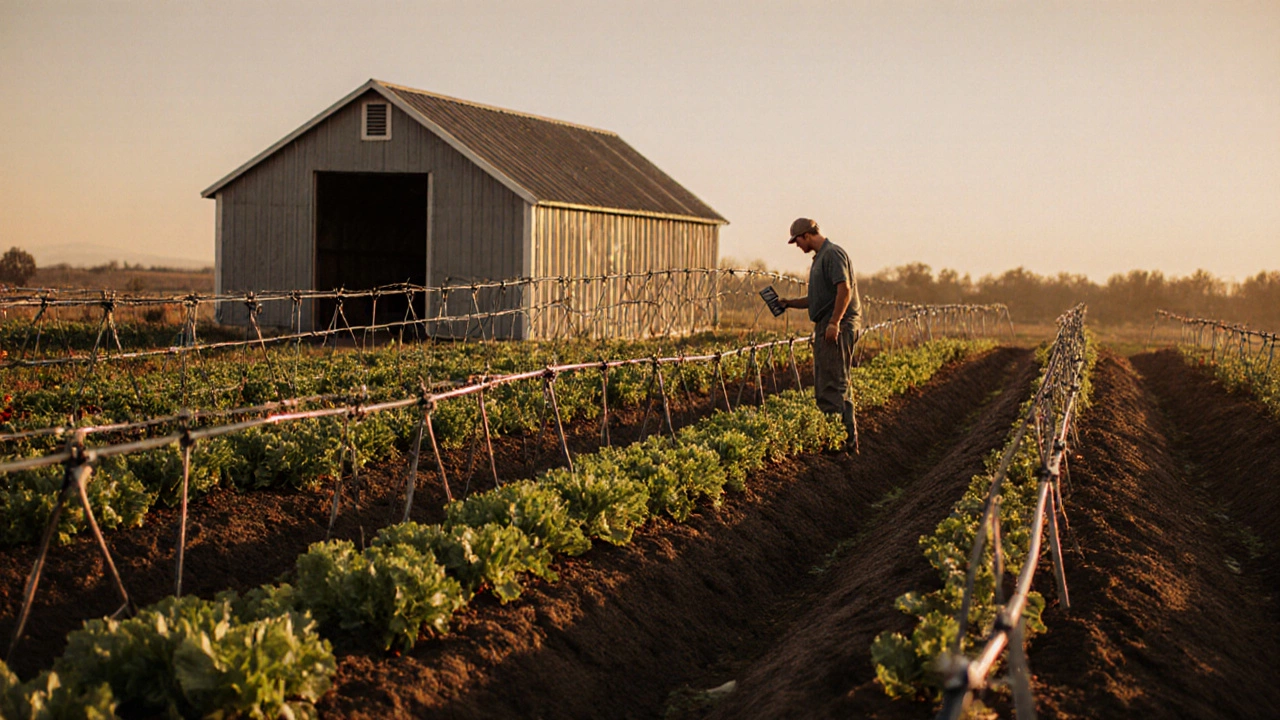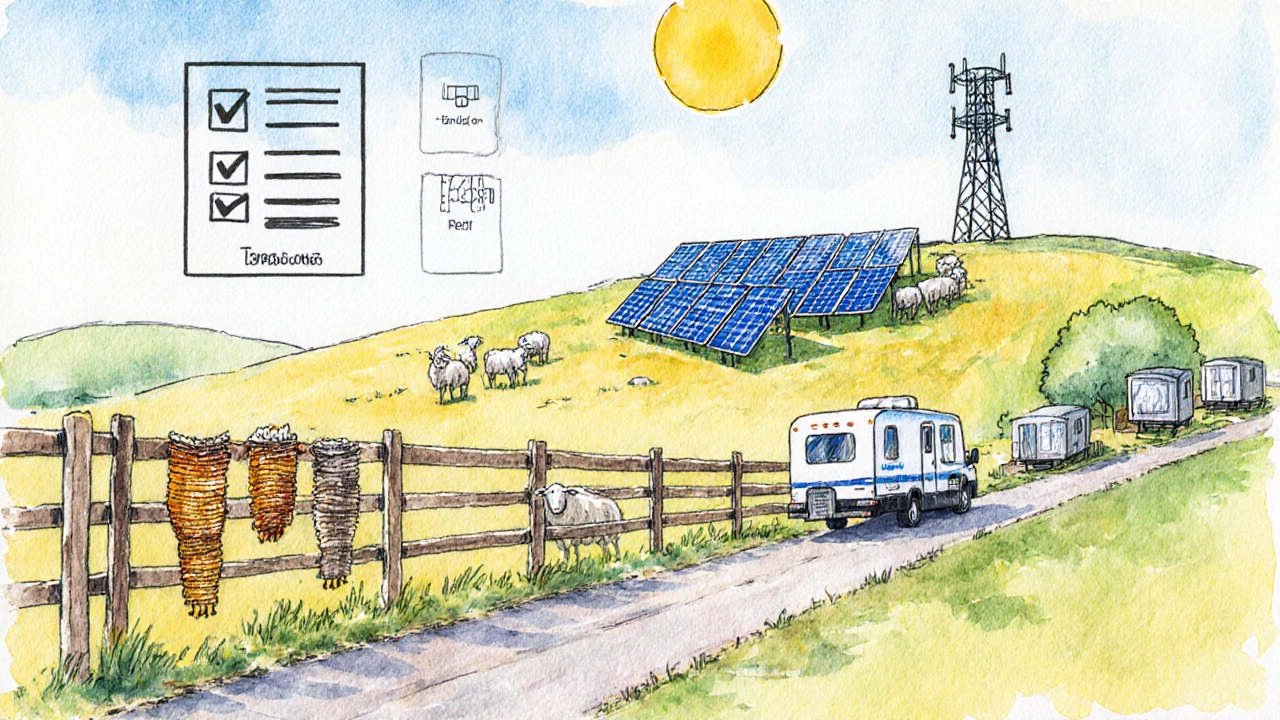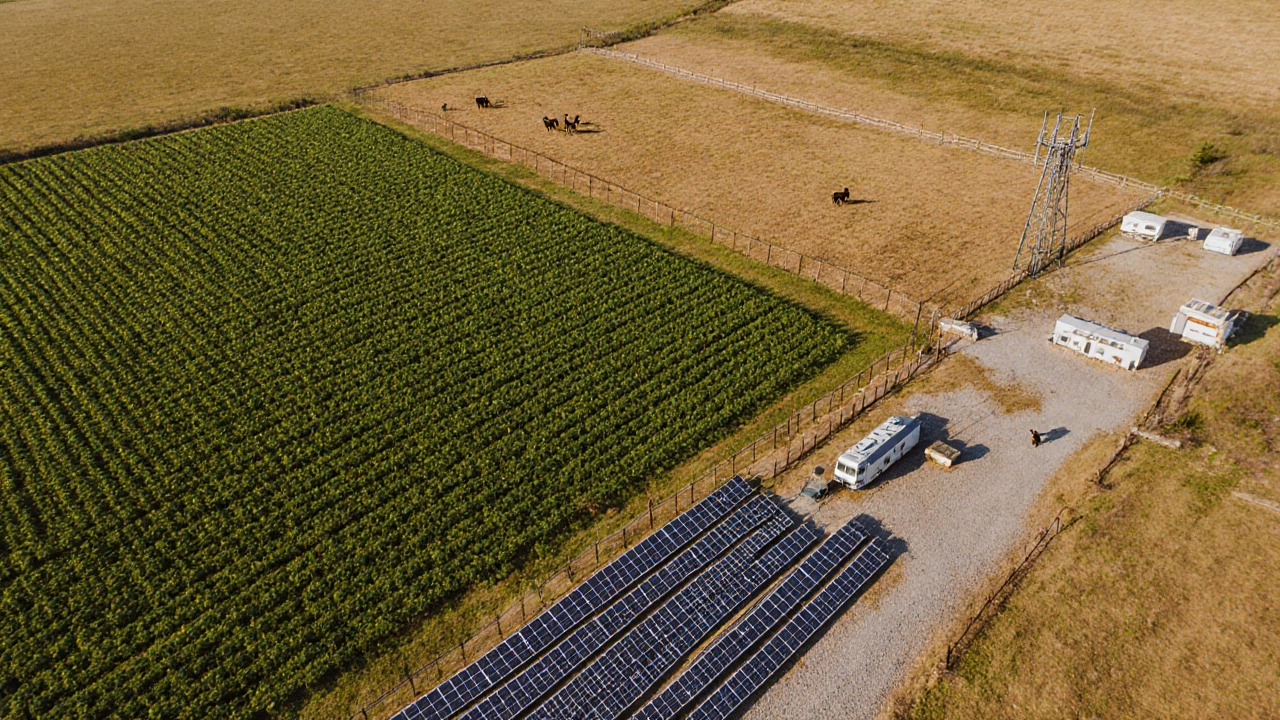20-Acre Income Potential Calculator
Projected Earnings Summary
Note: These projections are estimates based on general industry data. Actual results may vary depending on location, market conditions, and management practices.
Owning a 20‑acre parcel can feel like a blank canvas-except you need a cash flow plan. Below you’ll find realistic ways to turn those 87,120squarefeet into steady income, the costs you’ll face, and which option fits different skill levels.
Understanding the Base: What 20 Acres Really Means
20‑acre land parcel is a tract of land covering roughly 87,120squarefeet, typically enough for a small‑scale farm, a series of hobby plots, or a mixed‑use development. It offers flexibility, but the earnings potential hinges on three factors: soil quality, water access, zoning, and market demand.
Top Income‑Generating Uses for 20 Acres
Below is a quick snapshot of the most common revenue streams. Each entry includes a brief description, typical start‑up costs, and what kind of expertise you’ll need.
| Use | Initial Investment (USD) | Average Annual Revenue (USD) | Skill/Knowledge Needed | Time to Profitability |
|---|---|---|---|---|
| Organic vegetable farm | $30,000-$60,000 | $40,000-$80,000 | Agriculture basics, market access | 2-3 years |
| Pasture‑based livestock (goats/sheep) | $25,000-$45,000 | $35,000-$70,000 | Animal husbandry, herd health | 1-2 years |
| Timber or fast‑growth hardwood | $15,000-$30,000 | $20,000-$45,000 (per 10‑year cycle) | Forestry management | 8-10 years |
| Solar panel lease | $0-$5,000 (permits) | $15,000-$30,000 (lease) | Minimal, but zoning knowledge | Immediate |
| Hunting lease / wildlife management | $5,000-$10,000 (fencing, habitat) | $10,000-$25,000 | Understanding of local game | 1 year |
| RV or tiny‑home park | $40,000-$80,000 (infrastructure) | $50,000-$90,000 | Hospitality, local zoning | 2-3 years |
| Beehive apiary | $3,000-$6,000 | $8,000-$15,000 (honey, pollination fees) | Beekeeping basics | 1 year |
| Cell‑tower lease | $2,000-$4,000 (site prep) | $12,000-$20,000 | Negotiation, telecom regulations | Immediate |
Deep Dive: How to Start an Organic Vegetable Farm
Organic vegetable farming is a proven route for landowners who enjoy hands‑on work and have good soil. Start by testing the soil pH; a range of 6.0‑7.0 is ideal for most vegetables. Next, design a crop rotation plan-e.g., tomatoes → beans → leafy greens-to keep soil nutrients balanced.
- Step 1: Secure a USDA‑organic certification if you plan to sell to premium markets. Costs run $300-$500.
- Step 2: Install drip irrigation. A 20‑acre system costs about $7,000 but saves water and labor.
- Step 3: Choose high‑value crops that match your climate-heirloom carrots, specialty lettuce, and micro‑greens can command $2-$4 per pound at farmers’ markets.
- Step 4: Build a simple packing shed (≈500sqft). Roughly $10,000 for a prefabricated structure.
- Step 5: Market directly: join a local CSA, sell at roadside stands, or list on online farm‑to‑table platforms.
First‑year net profit often falls between $5,000-$10,000 as you learn the ropes, but by year three many owners break even and start earning $60,000+ annually.
Pasture‑Based Livestock: Goats, Sheep, or Small Cattle
Livestock grazing leverages natural pasture, reducing feed costs. Goats thrive on brush and can clear invasive species, while sheep produce wool and meat. Small cattle (e.g., heritage breeds) need more space but fetch higher prices.
- Assess fencing-high‑tensile wire or electric fencing works best for 20 acres. Expect $2,500-$4,000.
- Start with 30-40 goats or 20 sheep; each animal requires about 0.25 acre of good pasture.
- Rotate pastures every 2-3 weeks to prevent overgrazing and minimize parasites.
- Market meat at local butcher shops or directly to restaurants; wool can be sold to fiber mills.
Annual revenue calculations (average market prices 2024): $800 per goat, $600 per sheep, $1,200 per small cattle. After feed, veterinary, and equipment costs, net profit often lands around $45,000‑$65,000.

Harvesting Timber: Fast‑Growth Hardwood or Pines
Timber production is a long‑term game. Species like southern pine or hybrid poplar grow quickly-reaching harvestable size in 7-10 years. The upfront cost is mainly tree seedlings and site preparation.
- Plant density: 400-500 trees per acre for fast‑growth varieties.
- Estimated yield: 2,000-3,000 board feet per acre per cycle.
- Timber prices (2024): $0.55 per board foot for pulpwood, $1.70 for sawlogs.
Over a 10‑year cycle, a 20‑acre stand can generate $30,000-$50,000 gross, making it a solid passive income stream once the forest is established.
Solar Panel Lease: Turning Sunlight into Cash
Solar farm leasing requires minimal land alteration. Utilities often pay $0.10‑$0.15 per kilowatt‑hour generated, translating to $15,000-$30,000 per year for 20 acres oriented south‑west.
- Check local zoning-many jurisdictions allow solar arrays on agricultural land under “dual‑use” rules.
- Negotiate a land‑lease agreement that includes annual escalations (e.g., 2% per year).
- Ensure the contract includes site‑maintenance responsibilities; most utilities handle panel upkeep.
Because the utility bears construction costs, the landowner’s only expense is permitting, typically under $5,000. Cash flow starts immediately after interconnection.
Hunting Leases and Wildlife Management
Hunting lease agreements let you rent out part of your land to hunters or outfitters. If your property has natural cover-woods, brush, or water sources-it can attract deer, turkey, or pheasant.
- Typical lease rates: $200-$500 per hunting permit per season.
- Invest in habitat improvements (e.g., supplemental feed, nesting boxes) for $5,000-$8,000 to boost game populations.
- Many owners supplement lease income with guided hunts, charging $1,000-$2,500 per day.
Annual net income can reach $20,000-$30,000, especially in regions with strong hunting culture.
RV or Tiny‑Home Park: Capitalizing on the Van‑Life Trend
RV parks and tiny‑home communities thrive near scenic routes or near outdoor recreation. A 20‑acre site can accommodate 30-40 RV sites, each with a 30‑amp hook‑up.
- Lay out roads and pads; basic gravel costs about $12 per square foot.
- Install utilities (water, sewer, electricity). Expect $30,000-$50,000 for a modest park.
- Charge $30-$45 per night or $350-$500 per month for long‑term spots.
With 30 occupied sites at an average of $400 per month, gross revenue tops $144,000 annually. After maintenance, insurance, and taxes, net profit typically falls in the $50,000-$80,000 range.
Beehives and Pollination Services
Beekeeping is low‑cost and adds ecological value. One hive can produce 30-60lb of honey per year, worth $10‑$15 per pound in specialty markets.
- Start with 10-15 hives; each requires a simple box costing $150-$250.
- Beyond honey, many farms sell pollination services to nearby orchards, fetching $100-$200 per hive per season.
- Annual net profit from honey and pollination can reach $12,000-$18,000.

Cell‑Tower Lease: Passive Income from Telecom
Cell‑tower leasing turns a small plot into a revenue generator for telecom carriers. Companies often pay $10‑$20 per square foot of tower footprint, plus a flat yearly rent.
- Identify whether your land sits in a coverage‑gap area-use tools like the FCC’s Antenna Structure Registration database.
- Negotiate a lease that includes a base rent of $12,000-$20,000 and escalation clauses.
- Ensure the agreement covers site access, liability, and de‑installation after the contract ends.
Because the carrier funds tower construction, your out‑of‑pocket costs are limited to site prep (grading, access road), generally under $5,000.
Choosing the Right Path: Decision Checklist
- Do you enjoy daily hands‑on work? → Vegetable farm, livestock, beekeeping.
- Do you prefer passive cash flow? → Solar lease, cell‑tower lease, timber.
- Is there strong local demand for outdoor recreation? → RV park, hunting lease.
- What’s your capital budget? → Low (< $10k): beekeeping, hunting lease; Medium ($30k-$60k): livestock, vegetable farm; High (> $80k): RV park, orchard.
- How quickly do you need income? → Immediate: solar lease, cell‑tower lease; 2‑3 years: farm, RV park; 8‑10 years: timber.
Common Pitfalls and How to Avoid Them
Even seasoned landowners hit snags. Here are the most frequent mistakes and quick fixes:
- Ignoring zoning. Always verify local land‑use codes before investing. A brief chat with the county planning office can save thousands.
- Under‑estimating water needs. Install a water rights assessment early; irrigation costs balloon if you discover scarcity later.
- Over‑leveraging debt. Stick to a debt‑to‑equity ratio below 50% for most projects; a modest loan can be useful but avoid full‑property financing.
- Choosing a single revenue stream. Diversify-pair a vegetable farm with a beehive or a hunting lease with a solar panel array to smooth cash flow.
- Neglecting marketing. Even the best product won’t sell without a plan. Allocate at least 5% of start‑up costs to branding, online listings, and community outreach.
Next Steps: From Idea to Action
Pick the use that feels right, run a quick feasibility check, then move to a detailed business plan. Below is a simple 5‑step roadmap you can copy‑paste.
- Survey the land. Map soil, water sources, slope, and existing structures.
- Research local market demand. Talk to nearby farms, retailers, and community groups.
- Calculate costs & revenue. Use the comparison table as a baseline, then adjust for your region.
- Secure financing. Look at USDA loans, local credit unions, or micro‑loans for small farms.
- Start small, scale fast. Begin with a pilot plot or a handful of animals, then expand as cash flow stabilizes.
With a clear plan and realistic expectations, 20 acres can move from a static asset to a thriving income generator.
Frequently Asked Questions
What’s the fastest way to earn money on 20 acres?
Leasing the land for a solar array or a cell‑tower can produce cash flow the moment the utility or carrier turns on service. Both options require minimal upfront expense and no ongoing labor.
Can I combine multiple income streams on the same 20 acres?
Absolutely. A common combo is a small organic vegetable garden on the fertile low‑lying portion, a few beehives for pollination and honey, and a solar lease on the sunnier, less productive side. This layers short‑term cash with longer‑term passive income.
Do I need a special permit to start a tiny‑home park?
Most counties classify tiny‑home parks as a type of temporary accommodation, which often requires a conditional use permit and compliance with health‑department standards for water and sewage. Checking with the local planning department early avoids costly re‑work.
How much water will a 20‑acre vegetable farm need?
A typical drip‑irrigated vegetable operation uses about 1.5-2 acre‑feet of water per acre each growing season. That translates to roughly 30,000-40,000gallons for 20 acres. Installing a water‑meter and rain‑sensing controller can cut usage by 15-20%.
Is it legal to sell honey directly to consumers?
Yes, but you must comply with state food‑safety regulations, which often include a permit, labeling requirements, and occasional inspections. Many states treat honey as a low‑risk product, making the process straightforward.





